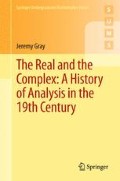Abstract
Dedekind had ushered in the idea that mathematical concepts might profitably be defined in terms of a naive conception of sets. His friend Cantor extended this to a theory of sets of various sizes, and came to a number of paradoxical conclusions, such as the existence of a one-to-one correspondence between a line and a square, which threatened the fundamental idea of the dimension of these and other domains.
Access this chapter
Tax calculation will be finalised at checkout
Purchases are for personal use only
Author information
Authors and Affiliations
Corresponding author
Rights and permissions
Copyright information
© 2015 Springer International Publishing Switzerland
About this chapter
Cite this chapter
Gray, J. (2015). Cantor, Set Theory, and Foundations. In: The Real and the Complex: A History of Analysis in the 19th Century. Springer Undergraduate Mathematics Series. Springer, Cham. https://doi.org/10.1007/978-3-319-23715-2_28
Download citation
DOI: https://doi.org/10.1007/978-3-319-23715-2_28
Published:
Publisher Name: Springer, Cham
Print ISBN: 978-3-319-23714-5
Online ISBN: 978-3-319-23715-2
eBook Packages: Mathematics and StatisticsMathematics and Statistics (R0)

